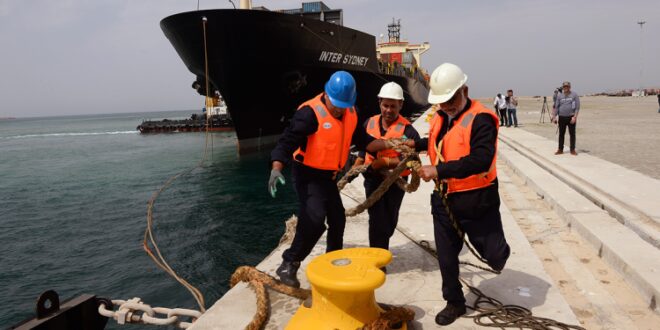Since the early days of independence in late 1991, the governments in Kazakhstan, Kyrgyzstan, Tajikistan, Turkmenistan, and Uzbekistan have pointed to the map to show Central Asia’s potential as a major transit hub for east-west and north-south trade.
Realizing that potential has not been so easy.
China was anxious to help build the infrastructure to bring Central Asian resources — oil, natural gas, and minerals — back to China, and that opened up Central Asian trade to the east.
The maritime route across the Caspian Sea faces a bottleneck when cargo reaches Azerbaijan. Only a few roads and railways traverse the South Caucasus to the Black Sea or Turkey, limiting the ability to move goods from Central Asia westward through this corridor.
In addition to wanting trade with countries to the west, Central Asia has long wanted to open up routes to the south, to access markets in India, the Middle East, and eastern Africa. But for decades, instability in Afghanistan and political complications around incorporating heavily sanctioned Iran into transregional trade corridors made this impossible.
When Russia launched its full-scale invasion of Ukraine in late February 2022, it prompted the Central Asian states, and others, to reconsider Iran’s potential role as a transit country. In a little more than two years, Central Asia’s view of Iran has changed from international pariah to key link in lucrative trade routes.
Troubled relations
The systems of government in the five Central Asian states, to varying degrees, are still modeled on the Soviet Union. Even today, more than 30 years after its collapse, many of the top officials in Central Asian governments started their political careers in Soviet times. For officials who come from a Soviet atheist background, one of their greatest fears is being overthrown by an Islamically inspired rebellion. Iran’s theocracy, albeit based on Shi’a Islam as opposed to the Sunni Islam most people in Central Asia practice, is a dangerous model for the Central Asian governments — as is the fundamentalist Deobandi form of Sunni Islam enforced by the Taliban in Afghanistan.
Additionally, for more than a decade after independence, most of the Central Asian states sought closer ties with the United States. At first, the US served as a counterweight, providing protection from possible reincorporation by former colonial master Russia. After 9/11, the US became the world power that ousted the Taliban in neighboring Afghanistan. Most of the Central Asian governments were hostile to the Taliban in the late 1990s, especially the governments of Uzbekistan and Tajikistan, which supported, respectively, Uzbek and Tajik anti-Taliban forces in northern Afghanistan, and the Taliban reciprocated by harboring a Central Asian militant group that attacked areas of Kyrgyzstan and Uzbekistan in the summers of 1999 and 2000.
Not surprisingly, the Central Asian governments were not anxious to pursue strong ties with Iran during these years. In 1995, former Uzbekistani President Islam Karimov went as far as supporting the US trade embargo on Iran. Even in Tajikistan, where the majority of the people, and the Tajik language, are of Persian origin, relations with Iran were at times icy.
Iran did help construct a new hydropower plant in Tajikistan and build parts of a key highway connecting the north and south areas of the country. There were also two gas pipelines built to export gas from Iran’s northern neighbor, Turkmenistan, and an oil swap deal between Kazakhstan and Iran. On the whole though, there was generally minimal interaction between Iran and Central Asia for 30 years.
Post-February 2022
The sanctions Western countries imposed on Russia for the invasion of Ukraine in 2022 greatly changed the situation for Central Asia. From independence until the start of 2022, Central Asia continued to depend predominantly on road and railway networks through Russia to conduct trade with Turkey and Europe, partly because of the slow progress in opening maritime trade routes across the Caspian Sea.
That trade was suddenly threatened, and Central Asian governments sought alternatives.
At the end of May 2022, Tajikistani President Emomali Rahmon visited Tehran, followed the next month by Turkmenistan’s President Serdar Berdymukhammedov and President Kasym-Zhomart Tokayev of Kazakhstan.
Rahmon’s visit was significant as Iranian-Tajikistani relations had been glacial since August 2017, when Tajikistan’s authorities accused Iran of being behind political assassinations in the Central Asian country during and after its 1992-97 civil war.
The Turkmenistani president’s visit helped mend a rift that started in January 2017, when Turkmenistan halted gas exports to Iran, citing a 10-year-old debt for gas payments that Iran disputed.
President Tokayev’s visit was timed to coincide with the arrival in Tehran of a freight train that left northeastern Kazakhstan the week before, carrying goods to Turkey on a test run of the new route. That railway takes some 12 days to travel from Kazakhstan to Turkey.
President Shavkat Mirziyoyev went to Iran in June 2023, the first visit to the country by an Uzbekistani president in 20 years.
High on the agenda during all these visits was the issue of transportation and transit between Central Asia and Turkey, or more broadly between China and the European Union.
The freight train from Kazakhstan in June 2022 was followed several months later by another train taking a different course. Tajikistan launched its multimodal route from China to Turkey via Uzbekistan, Turkmenistan, and Iran on Oct. 19, 2022, when the first freight train left the station in Kulob, southern Tajikistan. That multimodal route connects by road from Dushanbe to China.
Those trade routes were already under construction and nearing completion when Russian troops crossed en masse into Ukraine in late February 2022, but the projects seemed to have opened the door to involve Iran in plans for expanding east-west trade corridors.
At a July 2023 meeting of Kazakhstani Deputy Prime Minister Serik Zhumangarin and his Uzbekistani counterpart, Jamshid Hojayev, there were discussions about a multimodal route from Iran through their countries to China. In August, the presidents of Tajikistan, Turkmenistan, and Uzbekistan met in Ashgabat for talks that included trade and transit corridors through their countries and Iran.
Representatives of the transport ministries from Turkmenistan, Uzbekistan, Kazakhstan, Turkey, and Iran met in late October 2023 to discuss increasing road and rail use.
In addition, the China-Kyrgyzstan-Uzbekistan (CKU) railway project is finally moving ahead, after more than 25 years of discussions and planning. The Organization of Turkic States (OTS), which has Turkey, Azerbaijan, Kazakhstan, Kyrgyzstan, and Uzbekistan as members, with Turkmenistan expected to upgrade its status from observer to full member later this year, has already been discussing linking the CKU railway to transport and transit corridors leading through Iran to Turkey. The opening of the CKU would reduce travel time from China to Turkey by up to eight days.
Developing a north-south trade corridor
The Central Asian countries have been seeking trade routes to India for three decades. Some tentative progress has been made through Afghanistan since 2022 moving cargo by road and using Pakistani ports to ship goods to and from India. However, volumes remain modest due to the poor road network and lack of railways in Afghanistan, as well as restrictions on moving goods between Pakistan and India.
On July 12, 2022, less than a month after the Turkey-bound train from Kazakhstan arrived in Tehran, a train from Russia carrying construction materials arrived at the Sarakahs station, on the Turkmenistani-Iranian border. That train continued on to Iran’s Persian Gulf port at Bandar Abbas, where the cargo was loaded on a ship and taken to India.
Uzbekistan has also showed interest in joining the route to India. In September 2022, its Ministry of Investment and Foreign Trade hosted a meeting with representatives of the United Nation’s Economic and Social Commission for Asia and the Pacific (ESCAP) to discuss developing a transport corridor running from Uzbekistan through Turkmenistan, Iran, and via the latter’s Persian Gulf port at Chabahar, to India. Already in January 2023, Uzbekistan was using the north-south trade corridor as a shipment of sesame seeds from India passed through Iran, Turkmenistan, and Uzbekistan en route to buyers in Almaty, Kazakhstan. The trip from Mundra, India to Almaty took 20 days.
Iran and Uzbekistan signed agreements to establish a joint logistics center at Bandar-Abbas and Chabahar and for businesses from Uzbekistan to take part in the construction of terminals and storage facilities at both ports.
Iran has been offering the Central Asian states use of both the Bandar-Abbas and Chabahar ports. Tehran proposed their use to Kyrgyzstan in early 2023 as incentive for joining in trade routes from China through Central Asia to Iran and farther to India, the Middle East, and East Africa.
In May 2024, India Ports Global Ltd. signed a 10-year contract to develop and operate the Chabahar port, which should make use of the facility even more attractive for Central Asian countries looking to trade with India.
Conclusion
The political limitations on using traditional trade routes through Russia have forced Central Asian governments to finally, and energetically, pursue alternatives. Routes such as the Asian Development Bank’s Central Asia Regional Economic Cooperation (CAREC), the Trans-Caspian International Transport Route (TITR), or China’s Belt and Road Initiative (BRI) already existed but were secondary considerations for the Central Asian states. Now, those corridors are vital for Central Asia, but to utilize those routes to maximum benefit, Iran must be involved.
This Iranian involvement might not be welcomed by Western nations, but the US and Europe are cutting Central Asia’s trade routes west through Russia and trans-Caspian routes are still insufficient to act as a substitute to the Russian corridor.
Additionally, routes from Central Asia through Iran have strong backing from China, Turkey, and Arab states, so the Central Asian states can count on the support of those countries if Western nations raise objections.
 Eurasia Press & News
Eurasia Press & News


